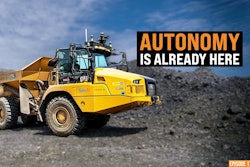Things are changing in the engine-oil world, “faster than most of us realize,” says this week’s guest on The Dirt.
Kevin Carabell, regional technical services team lead for Chevron Lubricants, guides us through these changes as well as provides a clear, easy-to-understand explainer on what contractors need to know about choosing the right oil viscosity.
Those numbers on the oil bottle are important to determining the right oil for the conditions your heavy equipment will be working in. Carabell explains what those numbers really mean and how they affect your machines.
So to learn more about what’s going on inside your engine and how to choose the right oil to keep it running in top condition, check out the latest episode of The Dirt.
Equipment World serves up weekly videos on the latest in construction equipment, work trucks and pickup trucks – everything contractors need to get their work done. Subscribe and visit us at equipmentworld.com!
In This Episode:
- 00:00 – Engine Oil Viscosity
- 00:32 – What is Engine Oil Viscosity?
- 02:40 – Why Do Engine Oils List 2 Viscosities?
- 04:43 – Why Should I Pay Attention to Engine Oil Viscosity?
- 08:43 – What Kind of Oil Will Be in the Newest Upcoming Engines?
- 09:53 – Why are We Able to Transition to Thinner Oils?
- 10:57 – Final Thoughts
00:00:05:06 - 00:00:31:20
Bryan Furnace
Today we're back to talk about motor oil, but this time we're going to talk about viscosities. More specifically, what are viscosities like? I know it has to do with thickness of oil, but what does that mean for my engine and why are viscosities changing? Today we're joined by Kevin with Chevron, and he's going to talk to us more about what all of this means.
00:00:31:22 - 00:00:34:23
Bryan Furnace
Well, Kevin, thank you so much for being back on the dirt. It's good to see you again.
00:00:35:05 - 00:00:38:04
Kevin Carabell
Yeah, great to be here. Thank you for inviting me I appreciate it.
00:00:38:06 - 00:00:55:04
Bryan Furnace
Yeah, absolutely. So my first question is when we talk about viscosities, you know, on this side, on the front lines as people who don't really know a whole lot about oils, we talk about, you know, 1030 1540 what are we actually talking about there? What is viscosity?
00:00:55:09 - 00:01:21:08
Kevin Carabell
Yeah, it's a good question. And rather than getting into sort of a deep scientific description of it, let's try to connect it to the reality that people experience. Viscosity is a measure of a fluid's resistance to flow. Okay. This is kind of one way to think about it. So we know that water flows easily. And so we say water has extremely low viscosity.
00:01:21:10 - 00:01:43:04
Kevin Carabell
Honey on the other hand, takes a little bit of effort to get it to flow and has a very high viscosity. So the viscosity of the fluid is there to keep moving surfaces apart. And that's probably the most important consideration to avoid friction and wear an engine. And in an engine, you've got different conditions. Temperature. We know temperature affects viscosity.
00:01:43:06 - 00:02:12:18
Kevin Carabell
So an engine oil that is as thick as honey at -20°F will be almost as thin as water at 300°F. So the viscosity of the oil changes with temperature. And there's another condition that we call shear. And you intuitively know it. Shear is if you think of the narrow passages in an engine like between bearings and shafts, that's a high shear environment.
00:02:12:18 - 00:02:33:14
Kevin Carabell
It takes a lot of work to force the oil through those orifices and narrow gaps. So that's a high shear environment. A low shear environment is maybe the oil just flowing through the the oil galleries. Right. There's still some shear going on, but it's it's pretty low. So that's kind of how I think of oil and just kind of tying that back.
00:02:33:14 - 00:02:39:19
Kevin Carabell
The important thing to keep in mind is you want the right viscosity at the right conditions.
00:02:39:21 - 00:02:51:12
Bryan Furnace
So why are oils listed with two. Viscosity is versus like an C30 or whatever. Why is there only one viscosity there. But in a lot of our engine oils we have two. Viscosity is listed.
00:02:51:14 - 00:03:12:12
Kevin Carabell
So that's a system that was put in place to enable people to make intelligent buying decisions. And it's a good system. And there's two numbers that that people generally see. You'll describe it as a like a 15 W 40. So the 15 W would be the first number. And that tells you the winter grade. It's a good way to remember it.
00:03:12:17 - 00:03:38:01
Kevin Carabell
And lower numbers will tell you that the oil is suitable for use in very cold weather. So these these oils have been checked performance wise to make sure that you can start and lubricate your engine. And a 15 is good down to about four degrees below zero Fahrenheit ten W runs down to -13 A, five W -22 and A0W -31°F.
00:03:38:03 - 00:03:38:21
Bryan Furnace
Okay.
00:03:38:23 - 00:04:03:05
Kevin Carabell
That's what that's telling you. And even, you know, even in Wisconsin, -30°F. It's pretty cold. And and so zero Ws are for those really cold conditions, 15 are for the warmer conditions. The second number is the 30 or 40 in most heavy-duty service. But there's other numbers now that you may not be aware of. There's 20 weights and there's now even eight weights and 16 weights.
00:04:03:05 - 00:04:05:09
Kevin Carabell
These are really thin oils.
00:04:05:11 - 00:04:06:05
Bryan Furnace
Interesting.
00:04:06:10 - 00:04:24:21
Kevin Carabell
Yeah. And to the second number tells you how the oil flows in a hot engine. So a higher number will give you a thicker oil film. Lower numbers mean that the oil is easier to pump. And of course that pump takes work to push the oil through those narrow galleries. So more viscous oil takes more work, and it uses up more fuel.
00:04:25:02 - 00:04:41:00
Kevin Carabell
It's small, right? One 1%, 2%, something like that. But a 1030 saves you about 1.2% over 15 before you just kind of a round number. So the way to think of it, higher numbers, hotter temperatures, lower numbers, colder temperatures, that's kind of the way to think about it.
00:04:41:06 - 00:04:56:20
Bryan Furnace
Gotcha. That makes total sense. Now I guess for a consumer on this end of it, why do I care about viscosity. What impact does that have? Why not just throw, you know, a 1030 in any engine? Why do I need to worry about the differences in viscosity?
00:06:52:07 - 00:07:16:07
Kevin Carabell
Well, the purpose of a lubricant is to control friction and wear, and it's it's important to match the right viscosity to the equipment and its use. Thicker oils are going to give you a heavier oil film when the oil is hot. But a lot of wear happens when you cold start equipment and a somewhat thinner oil like a 1030 is going to flow through the engine more quickly than a 1540 will when cold.
00:07:16:09 - 00:07:38:03
Kevin Carabell
And so you will actually get less wear with a thinner oil. If you have a lot of cold starts, it's kind of counter intuitive to thicker oil when it's cold won't get to where it's needed. My mantra is you want to match the viscosity to the application, right? Heavy duty pushes the limits on engine oils, oxidation, nitrogen wear, corrosion.
00:07:38:03 - 00:08:01:19
Kevin Carabell
Heavy duty service is hard on engine oils. Older equipment was designed for fuels and engine oils of the day. But things have changed. We've talked about this before. Since 2010, we've taken most of the sulfur out of diesel fuel that reduces corrosion and oil degradation, and now most OEMs factory fuel with ten, 30, and at least one OEM uses an Fe 4 or 530 is a factory fill oil.
00:08:01:20 - 00:08:35:09
Kevin Carabell
Oil pumps are a lot better now. Oil pumps are a lot more efficient. They take less power, they heat the oil less, and oil pumps can now dynamically match the flow in the load to the conditions the equipment is under. Some engines can even turn on or off the cooling jets used to spray pistons. My point is, engines are a lot more sophisticated now, and so to take advantage of fuel economy and other benefits, newer engines can use lighter oils than you've traditionally been used to, and there is no where penalty.
00:08:35:09 - 00:08:38:10
Kevin Carabell
They're engineered and designed for these lighter oils.
00:08:38:12 - 00:08:54:14
Bryan Furnace
Interesting. So that that actually is a perfect segue into my next question, which is why is it that that diesel engines traditionally have used the heavier, thicker oils and, and what is now kind of allowing us to transition to thinner oils?
00:08:54:16 - 00:09:06:16
Kevin Carabell
It's all around the the design. You're going to see with the next category that's coming up. Actually, the preference of heavy-duty OEM engine builders these days tend to be 30.
00:09:06:18 - 00:09:07:08
Bryan Furnace
Interesting.
00:09:07:08 - 00:09:32:13
Kevin Carabell
And you're going to see even lower viscosity oils are going to become more common. In actual fact, I believe probably want to talk to an engine builder. That might be hard to do, but I think these engines are going to run better on ten 30s and 1540s. And I know at least a couple OEMs are considering not even allowing 1540s in some markets in the U.S they will allow 1540s.
00:09:32:13 - 00:09:53:13
Kevin Carabell
So I'm not trying to start a panic or anything. Sure. But in some markets the expectation is people are just going to abandon 1540s for brand new, PC 12 kind of equipment. This is a few years from now. This isn't happening right away, but the whole emphasis is on reducing fuel consumption and interesting.
00:09:53:18 - 00:10:00:02
Bryan Furnace
So what has allowed the coming down on the viscosities? Why haven't we traditionally been able to do that?
00:10:00:04 - 00:10:28:07
Kevin Carabell
I think the expectation that most people have is a thicker oil gives you better wear protection. And and that's true under most conditions. But a lot of wear happens when an engine is cold. And with the newer high pressure oil pumps that can match performance to the conditions, an oil film can be provided. That works just fine. Even with the lower viscosity oil, you don't need heavier oil to have that protective oil film.
00:10:28:09 - 00:10:47:11
Bryan Furnace
That's fascinating the more I talk. I have said it before, but the more I talk to you guys and learn about kind of all of the inner workings behind the scenes of what goes into a motor oil. It's just I continue to be fascinated at the technology and the development and just the evolution of these oils as they've come along.
00:10:47:12 - 00:10:49:07
Bryan Furnace
This is really interesting stuff.
00:10:49:09 - 00:10:52:21
Kevin Carabell
Things are things are changing. They're changing faster than most of us realize.
00:10:53:02 - 00:11:12:15
Bryan Furnace
Yeah. Well, Kevin, thank you again for the time. This has been super helpful. I appreciate it. Well, thank you again for Kevin coming on the show to educate us more on how viscosities impact our engines, the performance, and more importantly, why are these viscosities changing over time? As always, I hope this helps you in your business. We'll catch you on the next episode of The Dirt.










